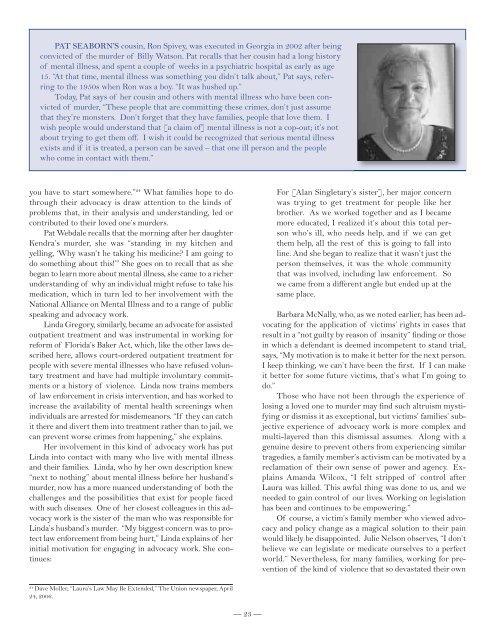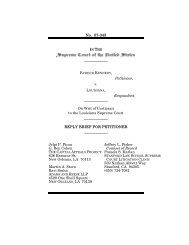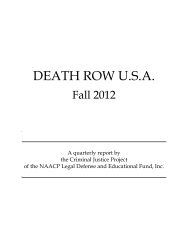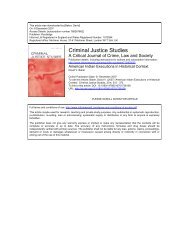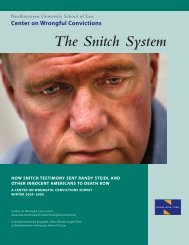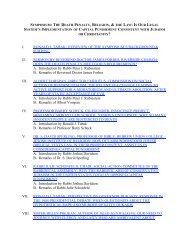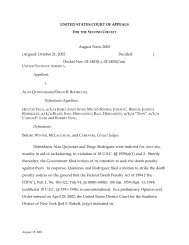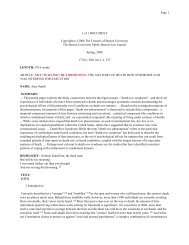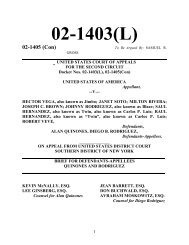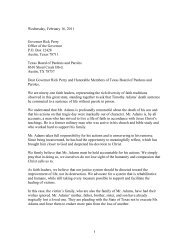Double Tragedies - Families for Human Rights
Double Tragedies - Families for Human Rights
Double Tragedies - Families for Human Rights
- No tags were found...
You also want an ePaper? Increase the reach of your titles
YUMPU automatically turns print PDFs into web optimized ePapers that Google loves.
PAT SEABORN’S cousin, Ron Spivey, was executed in Georgia in 2002 after beingconvicted of the murder of Billy Watson. Pat recalls that her cousin had a long historyof mental illness, and spent a couple of weeks in a psychiatric hospital as early as age15. “At that time, mental illness was something you didn’t talk about,” Pat says, referringto the 1950s when Ron was a boy. “It was hushed up.”Today, Pat says of her cousin and others with mental illness who have been convictedof murder, “These people that are committing these crimes, don’t just assumethat they’re monsters. Don’t <strong>for</strong>get that they have families, people that love them. Iwish people would understand that [a claim of] mental illness is not a cop-out; it’s notabout trying to get them off. I wish it could be recognized that serious mental illnessexists and if it is treated, a person can be saved – that one ill person and the peoplewho come in contact with them.”you have to start somewhere.” 24 What families hope to dothrough their advocacy is draw attention to the kinds ofproblems that, in their analysis and understanding, led orcontributed to their loved one’s murders.Pat Webdale recalls that the morning after her daughterKendra’s murder, she was “standing in my kitchen andyelling, ‘Why wasn’t he taking his medicine? I am going todo something about this!’” She goes on to recall that as shebegan to learn more about mental illness, she came to a richerunderstanding of why an individual might refuse to take hismedication, which in turn led to her involvement with theNational Alliance on Mental Illness and to a range of publicspeaking and advocacy work.Linda Gregory, similarly, became an advocate <strong>for</strong> assistedoutpatient treatment and was instrumental in working <strong>for</strong>re<strong>for</strong>m of Florida’s Baker Act, which, like the other laws describedhere, allows court-ordered outpatient treatment <strong>for</strong>people with severe mental illnesses who have refused voluntarytreatment and have had multiple involuntary commitmentsor a history of violence. Linda now trains membersof law en<strong>for</strong>cement in crisis intervention, and has worked toincrease the availability of mental health screenings whenindividuals are arrested <strong>for</strong> misdemeanors. “If they can catchit there and divert them into treatment rather than to jail, wecan prevent worse crimes from happening,” she explains.Her involvement in this kind of advocacy work has putLinda into contact with many who live with mental illnessand their families. Linda, who by her own description knew“next to nothing” about mental illness be<strong>for</strong>e her husband’smurder, now has a more nuanced understanding of both thechallenges and the possibilities that exist <strong>for</strong> people facedwith such diseases. One of her closest colleagues in this advocacywork is the sister of the man who was responsible <strong>for</strong>Linda’s husband’s murder. “My biggest concern was to protectlaw en<strong>for</strong>cement from being hurt,” Linda explains of herinitial motivation <strong>for</strong> engaging in advocacy work. She continues:For [Alan Singletary’s sister], her major concernwas trying to get treatment <strong>for</strong> people like herbrother. As we worked together and as I becamemore educated, I realized it’s about this total personwho’s ill, who needs help, and if we can getthem help, all the rest of this is going to fall intoline. And she began to realize that it wasn’t just theperson themselves, it was the whole communitythat was involved, including law en<strong>for</strong>cement. Sowe came from a different angle but ended up at thesame place.Barbara McNally, who, as we noted earlier, has been advocating<strong>for</strong> the application of victims’ rights in cases thatresult in a “not guilty by reason of insanity” finding or thosein which a defendant is deemed incompetent to stand trial,says, “My motivation is to make it better <strong>for</strong> the next person.I keep thinking, we can’t have been the first. If I can makeit better <strong>for</strong> some future victims, that’s what I’m going todo.”Those who have not been through the experience oflosing a loved one to murder may find such altruism mystifyingor dismiss it as exceptional, but victims’ families’ subjectiveexperience of advocacy work is more complex andmulti-layered than this dismissal assumes. Along with agenuine desire to prevent others from experiencing similartragedies, a family member’s activism can be motivated by areclamation of their own sense of power and agency. ExplainsAmanda Wilcox, “I felt stripped of control afterLaura was killed. This awful thing was done to us, and weneeded to gain control of our lives. Working on legislationhas been and continues to be empowering.”Of course, a victim’s family member who viewed advocacyand policy change as a magical solution to their painwould likely be disappointed. Julie Nelson observes, “I don’tbelieve we can legislate or medicate ourselves to a perfectworld.” Nevertheless, <strong>for</strong> many families, working <strong>for</strong> preventionof the kind of violence that so devastated their own24Dave Moller, “Laura’s Law May Be Extended,” The Union newspaper, April24, 2006.__ 23 __


